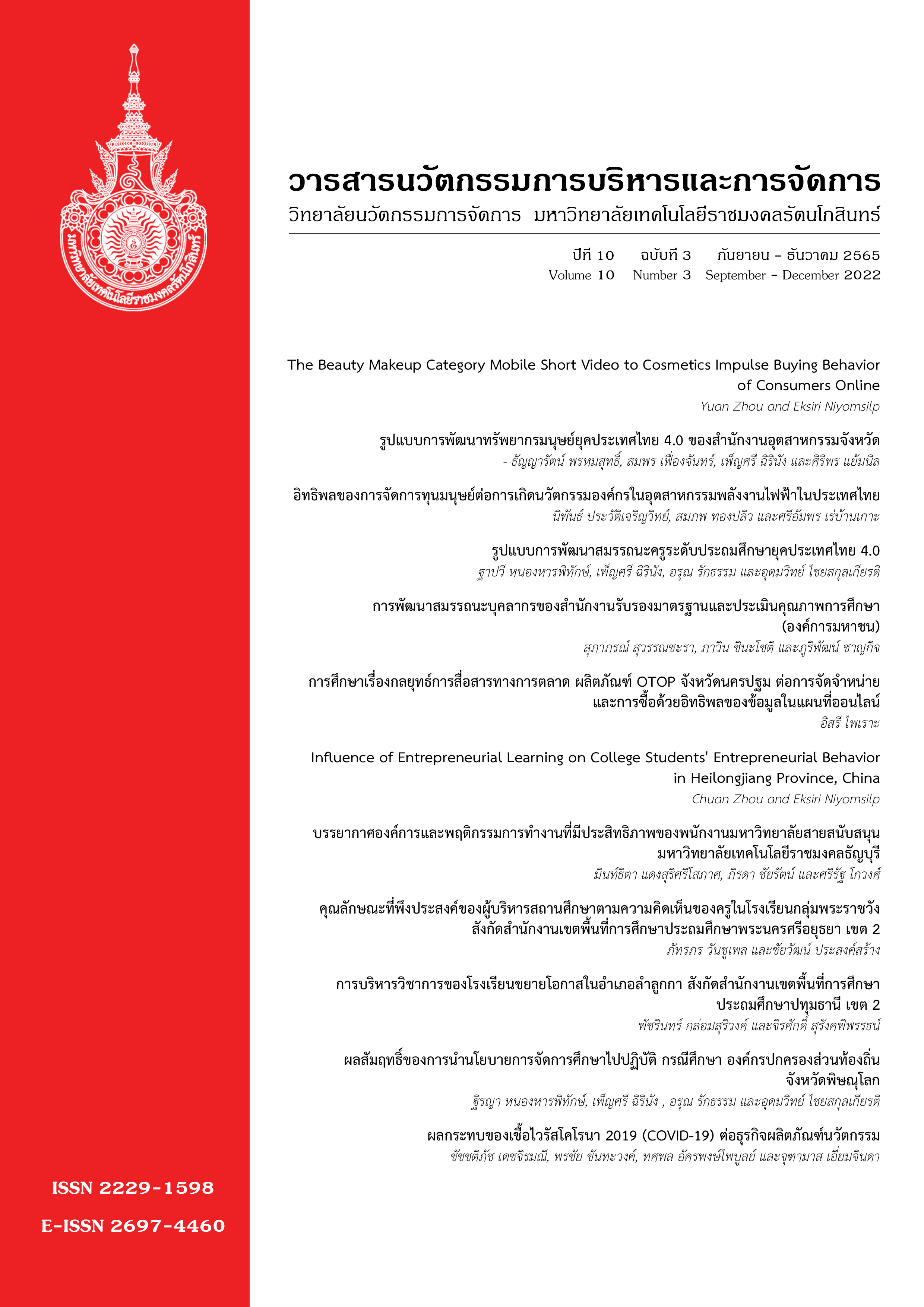The Beauty Makeup Category Mobile Short Video to Cosmetics Impulse Buying Behavior of Consumers Online
Main Article Content
บทคัดย่อ
With the development of information technology and smart phones, the use of short beauty videos has become the main marketing means of cosmetics enterprises, and many factors promote consumers' online purchasing behavior of cosmetics. Based on the S-O-R theoretical model, this study constructed a research model of the influencing factors of consumers' impulse purchase behavior of online cosmetics in the context of short beauty videos, and put forward relevant hypotheses. By collecting 525 questionnaires of consumers with purchasing behavior, SPSS was used for descriptive statistical analysis, reliability and validity analysis, factor analysis, regression analysis and structural equation model analysis. The results show that marketing stimulus, interaction, key opinion leaders, content, positive emotions and trust have significant positive effects on cosmetics online impulse buying behavior. Positive emotions and trust mediate between marketing stimulus, interaction, key opinion leaders, content and cosmetics online impulse buying behavior.
Article Details

อนุญาตภายใต้เงื่อนไข Creative Commons Attribution-NonCommercial-NoDerivatives 4.0 International License.
ข้อความและบทความในวารสารนวัตกรรมการบริหารและการจัดการ เป็นแนวคิดของผู้เขียน ไม่ใช่ความคิดเห็นและความรับผิดชอบของคณะผู้จัดทำ บรรณาธิการ กองบรรณาธิการ วิทยาลัยนวัตกรรมการจัดการ และมหาวิทยาลัยเทคโนโลยีราชมงคลรัตนโกสินทร์
ข้อความ ข้อมูล เนื้อหา รูปภาพ ฯลฯ ที่ได้รับการีพิมพ์ในวารสารนวัตกรรมการบริหารและการจัดการ ถือเป็นลิขสิทธิ์ของวารสารนวัตกรรมการบริหารและการจัดการ หากบุคคลใดหรือหน่วยงานใดต้องการนำทั้งหมดหรือส่วนหนึ่งส่วนใดไปเผยแพร่ต่อหรือกระทำการใดๆ จะต้องได้รับอนุญาติเป็นลายลักษณ์อักษรจากวารสารนวัตกรรมการบริหารและการจัดการก่อนเท่านั้น
เอกสารอ้างอิง
Adelaar. T., Chang, S. (2003). Effects of media formats on emotions and impulse buying intent.
Journal of Information Technology, 18(4), 247-266.
Bitner, M. J. (1992). Services capes: the impact of physical surroundings on customers and employees.
Journal of Marketing, 56(4), 57-72.
Chen, Xi. (2020). The Impact of E-Commerce Live Streaming on consumers Impulse Buying Behavior.
Nanjing: Nanjing university.
Chu, K., Yuan, B. J. C. (2013). The effects of perceived interaction on e-trust and e-consumer behaviors:
The application of fuzzy linguistic scale. Journal of Electronic Commerce Research, 14(1), 124-136.
Donovan, R. J., Rossiter, J. R. (1982). Store atmosphere: an environmental psychology approach.
Journal of Retailing, 58(1), 34-57.
Eroglu, S. A, Machleit, K. A. and Davis, L. M. (2003). Empirical Testing of a Model of Online Store Atmospherics
and Shopper Responses. Journal of Psychology & Marketing, 20(2), 139-150.
Fu, S., Yan, Q., and Feng, G. C. (2018). Who will attract you? Similarity effect among users on online purchase
intention of movie tickets in the social shopping context. Journal of Information Management,
(5), 88-102.
Konstantopoulou, A., Rizomyliotis, L., Konstantoulaki, K., et al. (2019). Improving SMEs’ competitiveness with
the use of Instagram influencer advertising and e WOM. Journal of Organizational Analysis,
(2), 308-321.
Li Xuesong. (2000). Store Atmosphere: A Marketing Stimulus not to be neglected.
Journal of Modernization of shopping malls, 2000(3), 33-34.
Mehrabian, A., Russell, J. A. (1974). An approach to environmental psychology. MIT, 7(1), 132-133.
Netemeyer, R. G., Bearden, W. O. (1992). A comparative analysis of two models of behavioral intention.
Journal of the Academy of Marketing Science, 20(1), 49-59.
Niu Chen, Liu Jin-ping. (2015). Influence of impulsive characteristics and money attitude on Impulsive buying
behavior. Journal of Psychological Research, 8(4), 57-62.
Pengnate, S. (Fone), Sarathy, R. (2017). An experimental investigation of the influence of website emotional
design features on trust in unfamiliar online vendors. Computers in Human Behavior, 67, 49-60.
Qimei Chen, Shelly Rodgers. (2006). Development of an Instrument to Measure Web Site Personality.
Journal of Interaction Advertising, 7(1), 4-46.
Ridings C.M. Gefen D. Arinze B. (2002). Some antecedents and effects of trust in virtual communities.
Journal of Strategic Information Systems, 11, 3-4.
Wu. L., Chen, K. W, and Chiu, M. L. (2016). Defining key drivers of online impulse purchasing: a perspective of
both impulse shoppers and system users. International Journal of Information Management,
(3), 284-296.
Yang Jianping and Ma Shuming. (2015). Research on the Influence of Mobile Phone Brand Image on consumers
purchase intention. Journal of Operations Management, 2015(2), 259-261.


